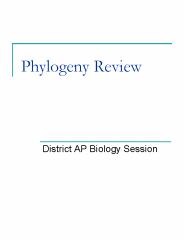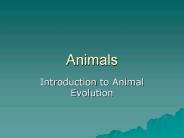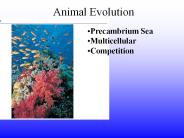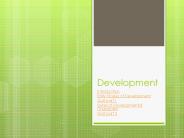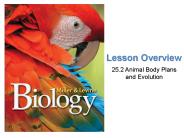Deuterostomes PowerPoint PPT Presentations
All Time
Recommended
Title: PowerPoint Presentation Author: Brenda Last modified by: bferguson Created Date: 1/1/1601 12:00:00 AM Document presentation format: On-screen Show (4:3)
| PowerPoint PPT presentation | free to view
Title: A View of Life Author: Valued Gateway Client Last modified by: kjones Created Date: 12/9/2002 2:36:15 AM Document presentation format: On-screen Show
| PowerPoint PPT presentation | free to view
Sessile filter feeders. Ciliated pharynx. NO notochord ... Sessile filter feeders. Ciliated tentacles and pharynx. Filtered food passes into intestine ...
| PowerPoint PPT presentation | free to view
Phylum Chaetognatha- arrow worms (resemble tiny, planktonic fish) More closely related to ... acorn worms. Not related to true worms. Stomochord-- notochord ...
| PowerPoint PPT presentation | free to view
Formation of Mesoderm and Coelom ... Cavity enclosed in mesoderm = coelom. Coelom: body cavity completely enclosed by mesoderm & not opening to outside. ...
| PowerPoint PPT presentation | free to view
Deuterostomes with coelom
| PowerPoint PPT presentation | free to view
Pharyngeal gill slits. Hollow nerve cord. Dorsal notochord. Post-anal tail ... Pharyngeal gill slits present at some stage in life cycle. ...
| PowerPoint PPT presentation | free to view
Jenna Hellack Fall 2000. The Coelomates: Deuterostomes, I ... Jenna Hellack Fall 2000. Class Crinoidea. Sea lilies and feather stars ...
| PowerPoint PPT presentation | free to view
muscular locomotory postanal tail at some point in life history ... tadpole stage in life history of all taxa. dioecious or hermaphroditic. Phylum Chordata ...
| PowerPoint PPT presentation | free to view
c. Blue Jay. a. Purple Martin. Quiz 10 b ... Sparrow. b. Great Horned Owl. c. Blue Jay. a. Purple Martin. Return to Quizzes Menu ...
| PowerPoint PPT presentation | free to view
Vertebrate Diversity Chapter 34 Senses: vision, but no color; olfaction; electrical senses * Chordate Phylogeny Phylum Chordata Bilaterian deuterostomes Derived ...
| PowerPoint PPT presentation | free to view
Echinoderms I. Deuterostomes Radial clevage Enterocoelous coelom formation Determiant clevage Blastopore becomes anus II. Echinoderm classes A. Asteroidea-starfish B ...
| PowerPoint PPT presentation | free to view
Vertebrate Diversity Chapter 34 Senses: vision, but no color; olfaction; electrical senses * Chordate Phylogeny Phylum Chordata Bilaterian deuterostomes Derived ...
| PowerPoint PPT presentation | free to view
Phylogeny Review District AP Biology Session Phylum Echinodermata The only invertebrate, nonchordate deuterostomes Sessile or slow moving Spiny skin Water vascular ...
| PowerPoint PPT presentation | free to view
AN INTRODUCTION TO ANIMAL EVOLUTION ECDYSOZOA Bilateral animals are divided into two clades Protostomes Deuterostomes Protostomes are themselves divided into two ...
| PowerPoint PPT presentation | free to view
e.g. flatworms, annelids, mollusks, arthropods. Deuterostomes ... Proboscis cavity. Nematoda. Organ System. Bilateral. No. Pseudocoelom. Annelida. Organ System ...
| PowerPoint PPT presentation | free to view
Koala hands adapt) Include plants and animals ... coelomates/deuterostomes/chordata/craniata/mammalia/diprotodontia/koala.htm ...
| PowerPoint PPT presentation | free to view
Animals Introduction to Animal Evolution What is an Animal? Multicellular, heterotrophic, eukaryotes Cells lack cell walls, held together by structural proteins ...
| PowerPoint PPT presentation | free to download
Title: Chapter 32 Author: sean reagin Last modified by: administrator Created Date: 5/13/2002 10:56:18 PM Document presentation format: On-screen Show
| PowerPoint PPT presentation | free to download
Cartilaginous fish (Class: Chondrichthyes) also efficient paired fins - sharks - skates, rays - ratfish. II. Animal Diversity. 3. Vertebrata. c. Jawed Fishes ...
| PowerPoint PPT presentation | free to view
sea stars - sea cucumbers - sea urchins. II. Animal Diversity. C. Bilateria ... filter feeders (Sea Lily), herbivores (sea urchins), predators (sea stars) ...
| PowerPoint PPT presentation | free to view
Echinoderms: Spiny-skinned animals Section 31.1 Animal Development Echinoderms are related to vertebrates due to their early development The gastrula is the early ...
| PowerPoint PPT presentation | free to view
Sea squirts or tunicates. Larvae show the characteristics of chordates ... Tunicate Larva. Adult tunicates. Subphylum Cephalochordata. Lancelets (Amphioxus) ...
| PowerPoint PPT presentation | free to download
Development Introduction Early Stages of Development Quiz part 1 Suites of Developmental Characters Quiz part 2
| PowerPoint PPT presentation | free to download
Jellyfish - Anemones. II. Animal Diversity. B. Radiata Cnidarians. 1. Diversity - Hydras ... Jellyfish - Anemones - Corals. II. Animal Diversity. a. ...
| PowerPoint PPT presentation | free to view
Animals = invertebrates and vertebrates (95% of all animals are invertebrates) Animal Characteristics The bodies of animals are multicellular.
| PowerPoint PPT presentation | free to view
Some organisms - body cavity - not completely lined by mesoderm. Pseudocoelomates include rotifers (phylum Rotifera), roundworms (phylum Nematoda).
| PowerPoint PPT presentation | free to download
Animal Bauplan Symmetry and complexity Chapter 3: Animal Architecture * * * * * * * * * * * * III. Symmetry Radial symmetry: body parts organized about a center axis ...
| PowerPoint PPT presentation | free to download
Title: PowerPoint Presentation Last modified by: bferguson Created Date: 1/1/1601 12:00:00 AM Document presentation format: On-screen Show (4:3) Other titles
| PowerPoint PPT presentation | free to view
Crinoidea (sea lilies) Asteroidea (starfishes) Ophiuroidea (brittle stars) Echinoidea (sea urchins) Holothuroidea (sea cucumbers) ...
| PowerPoint PPT presentation | free to download
Each animal phylum has a unique body plan. Vertebrates have an internal segmented backbone. Invertebrates do not have a backbone. Invertebrates encompass most animal ...
| PowerPoint PPT presentation | free to download
Now Three Domains and 6 Kingdoms. Conventional Classification of ... Hydra. sea pens. soft corals. 2 tissue layers: ectoderm, endoderm. sea anemones. jellyfish ...
| PowerPoint PPT presentation | free to download
Invertebrates Packet #77 Chapters 33 & 47 Introduction I Introduction II Invertebrates- Animals Without Backbones Ninety five percent of all known animals species are ...
| PowerPoint PPT presentation | free to download
Animal gametogenesis and embryology (chapters 25, 32, 47) What is an animal? ... nervous and muscle tissues are unique. distinctive stages of development ...
| PowerPoint PPT presentation | free to view
Early development and aging I. Embryonic development Day 1: fertilization 1. Cleavage 1. Cleavage 2. Gastrulation 3. Fate of the germ layers Two great groups of ...
| PowerPoint PPT presentation | free to view
Human Embryology. Fertilization. Fertilization- results in a zygote ... middle piece- contains mitochondria (make energy; ATP) ...
| PowerPoint PPT presentation | free to view
... Phylum Bryozoa Phylum Annelida Phylum Arthropoda Phylum Mollusca Enterocoelous Phylum Echinodermata Phylum Chordata Coelom Development Endoderm ...
| PowerPoint PPT presentation | free to download
... protostome Table 33.2 Classes of Phylum Platyhelminthes Figure 33.10 Anatomy of a planarian Figure 33.12 Anatomy of a ... Nematoda Roundworms ...
| PowerPoint PPT presentation | free to download
(Wray G, Knott E, 2000) Asteroizoa. Patiria miniata- Velvatida ... Knott E, Wray G (2000) Controversy and Consensus in Asteroid Systematics: New ...
| PowerPoint PPT presentation | free to view
Animal Evolution I. Animal traits A. Heterotrophic B. Mobile C. Lack cell walls D. Possess nerve and striated muscle D. Reproduces sexually 1.
| PowerPoint PPT presentation | free to view
KINGDOM ANIMALIA Characteristics of Animals 5. Segmentation Segmentation refers to the repetition of body parts that contain similar structures along the length of ...
| PowerPoint PPT presentation | free to view
1Animals multicellular, must get food through ingesting other ... Coelomates organisms with true coelom, (fluid-filled body cavity completely lined by mesoderm) ...
| PowerPoint PPT presentation | free to download
Invertebrates III and Vertebrates Class Actinopterygii Infraclass: Holostei (Primitive fish) Order: Lepisoteriformes - Bowfins Order: Amiiformes - Gars Bowfins Gar ...
| PowerPoint PPT presentation | free to download
(1) Bottom-dwelling filter feeder with lophophore arms (2) ... (Cephalochordate) (Urochordate) (Enteropneusts) Possible evolutionary tree of early vertebrates ...
| PowerPoint PPT presentation | free to view
Attach to substratum by secretions from an adhesive sac, then metamorphose to adult form. New colonies begin from this single metamorphosed primary zooid, ...
| PowerPoint PPT presentation | free to download
Vertebrates Lungfishes Classes of Chordates Tetrapods Classes of Tetrapods Amphibians Urodela ( tailed ones ) Salamanders Anura ( tailless ones ) Frogs and ...
| PowerPoint PPT presentation | free to download
Principles of Development Chapter 8
| PowerPoint PPT presentation | free to download
Are very diverse in form and habitat. Most reproduce sexually. Have a characteristic pattern ... 1. Separation of annelids and arthropods into different clades ...
| PowerPoint PPT presentation | free to view
Comparative Anatomy Vertebrate Phylogeny: Fishes Kardong Chapter s 2 & 3 Part 4 Vertebrate Classification Geological Eras of early vertebrates Paleozoic (oldest ...
| PowerPoint PPT presentation | free to view
Structural basis for assembly and sulfide binding in the 400kDa hemoglobin from the hydrothermal ven
| PowerPoint PPT presentation | free to view
C. Gastrulation in the sea urchin. D. Gastrulation in the ... Arthropods. Mollusks. Annelids. Echinoderms. Chordates. TIME. Fig. 32.7a. Cells NOT totipotent ...
| PowerPoint PPT presentation | free to download
Animals: The Invertebrates Chapter 25
| PowerPoint PPT presentation | free to download
BSC 2010L. INVERTEBRATES II. Principal Biological Concepts to Emphasize: ... you view '33A Characteristics of Invertebrates' on Student Media CD-ROM for review. ...
| PowerPoint PPT presentation | free to download
Gnathostomes Vertebrates with jaws. Derived Characters Jaws Duplication of Hox genes: Gave rise to larger brains, enhancing smell and vision.
| PowerPoint PPT presentation | free to download
Lesson Overview 25.2 Animal Body Plans and Evolution
| PowerPoint PPT presentation | free to download














